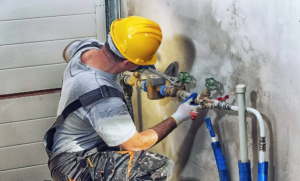Plumber Roswell installs and repairs systems that provide water, gas, waste disposal, and regulate indoor climate. They work from blueprints and building plans to lay pipes, install toilets and showers, and connect appliances.
Plumbers also collaborate with other professionals, including construction teams and architects, to integrate plumbing systems into new builds seamlessly. They must have strong customer service skills to communicate with clients and address their concerns.
Education and Training

There are a number of ways to enter the plumbing profession. Aspiring plumbers can take college courses at vocational schools or community colleges, or they can pursue an apprenticeship. An apprenticeship can last four to five years, and it combines on-the-job training with classroom instruction. Apprentices work with experienced plumbers and learn the trade while earning a salary. In addition to learning technical aspects of the job, they also receive classroom instruction on topics such as blueprint reading, local codes and regulations, and safety practices.
Once a plumber has completed an apprenticeship, he or she must pass an exam to become licensed in the field. Licensing requirements vary by location, but generally involve passing an exam on the fundamentals of plumbing. In some cases, license applicants may need to pass a practical test as well.
Plumbers frequently interact with customers, and customer service skills are important for the success of the career. They must be able to explain complex plumbing problems in understandable terms and provide accurate estimates for the work to be done. In addition, plumbing is often performed in tight spaces where physical strength is required to lift heavy equipment.
Many plumbers are members of professional associations, and this can provide them with access to exclusive educational resources, workshops, and seminars. Attending these events can help plumbers stay up-to-date on new technologies and industry trends. In addition, networking with other plumbers can lead to job referrals and insider knowledge about future openings in the field.
The demand for skilled plumbers is projected to increase by 15 percent over the next 10 years. This is faster than the average for all occupations. This increased demand is due to the fact that older plumbing systems are reaching the end of their useful life and will need to be replaced, and because newer buildings are being constructed with more sophisticated plumbing systems. In addition, people are living with higher water usage, which means that more plumbers will be needed to install and repair hydrants and water heaters. As a result, the job prospects for plumbers are excellent.
Apprenticeship
A plumbing apprenticeship offers the opportunity to earn while learning a trade. Apprentices work under the guidance of a journey worker and may receive on-the-job training as well as classroom instruction. Each program is unique, but most last two to five years and combine 144 hours of related classwork per year with at least 8,500 to 10,000 hours of on-the-job experience.
The apprenticeship program can be arranged through a local plumbers union, community college, or independent apprenticeship company. Each union will have its own guidelines for becoming an apprentice, so it is a good idea to contact one near you to get the latest information on programs and requirements.
Plumbers may also take part in a nationally recognized credentialing program offered by the National Joint Apprenticeship and Training Committee (JATC), which certifies that an apprentice has completed a qualified program of instruction that meets industry standards for quality and rigor. These credentials can be a great marketing tool when job searching, and they can lead to higher pay rates since they are portable between jobs and employers.
Many programs require applicants to take an aptitude test, so it is important to prepare for this beforehand. This will help you determine if you are a good fit for the program and increase your chances of success. If possible, try to find a practice test or study guide for the test.
Another useful skill to develop is customer service. Plumbers deal with customers a lot, so it is important to be friendly and polite. In addition, it can be helpful to have strong mechanical skills. This is because the more skilled you are, the faster you will be able to work and complete tasks.
A career as a plumber is not only lucrative, but it can be quite rewarding. As the number of jobs continues to grow, there will be even more opportunities for those who are trained and licensed. This is a great option for those who want to avoid the huge student loan debt that comes with going to college, but still wish to pursue a career that has a high salary potential.
Work Environment
Plumbing is a physically demanding profession. Many plumbers have to carry heavy pipe, crawl under buildings and work in cramped spaces. This can lead to back and joint problems for plumbers. In addition, some plumbers have to stand for long periods of time while working. Plumbing is often done in dirty environments, and plumbers may be exposed to sewage and other hazardous materials.
As a result, plumbers should have good physical condition and are typically required to wear safety gear, such as respirators and protective clothing. In some cases, plumbers must travel to job sites in vehicles, which can be stressful and require a lot of driving. Plumbers also may need to work on weekends and evenings to respond to plumbing emergencies, such as a burst water pipe.
A career as a plumber is relatively stable and offers decent earning potential. However, plumbers must be comfortable with the demands of this physically challenging job and its unpredictable schedule.
Many plumbers are self-employed, which gives them flexibility to set their own hours. Those who work for large plumbing companies might have to follow strict scheduling requirements, but they can often choose whether or not to accept emergency jobs. Plumbers can work for residential, commercial or industrial clients.
Plumbers typically start their day by reviewing job orders and preparing tools and equipment for the tasks ahead. Then they travel to the job site, which might be in a home, office building or factory. They work in tight and confined spaces, usually indoors, although they might be required to go outside for construction projects or to the roof of an older building.
Plumbers collaborate with other professionals, such as architects and construction teams, to ensure that plumbing systems are integrated seamlessly into building projects. They also work with customers to understand their needs and provide advice on plumbing solutions. Depending on the size of the company, a plumber might manage a team of other plumbing employees or contractors. In some cases, license holders can be responsible for hiring and overseeing the work of apprentices. They might also be able to obtain their own permits and inspect their work to ensure that it meets local plumbing codes.
Job Duties
Plumbing technicians install, connect and repair pipes, fixtures, appliances and other items used for potable water, waste disposal and venting. They also work with heating systems and other energy systems that intersect with plumbing. Plumbers often use specialized tools and work with blueprints and building codes to plan projects and ensure compliance with regulations. Plumbers may also respond to emergency calls and perform routine maintenance on water and gas pipes.
In addition to their plumbing skills, plumbers should have good customer service skills because they interact with clients frequently. They must be able to answer questions clearly and effectively, especially during a crisis, and provide accurate information about the problem and its cause.
Other job duties include inspecting existing plumbing to assess work requirements, using a variety of tools and equipment to test and diagnose problems, installing and repairing toilets, faucets, showers, sinks, garbage disposals and water heaters, assembling and soldering pipe sections and tubing, and resolving leaks. Some plumbers install and maintain backflow prevention devices, drain traps, sump pumps, sewage ejector systems, and backwater valves. Others may test for hazardous materials such as lead, asbestos, cadmium, and other toxic chemicals in plumbing and sewer systems.
Depending on their specialization, some plumbers focus on residential or commercial work. Commercial plumbers install and repair water systems, heating systems, and other large equipment used for business purposes. They may also specialize in installing or repairing sprinkler systems.
Plumbers must be able to read and interpret blueprints and plans, and they often work with contractors and construction teams to ensure plumbing systems are integrated seamlessly into new buildings. They must be comfortable working in cramped spaces and navigating tight corners, and they must have good manual dexterity to work with hand tools.
Many plumbing jobs require on-call shifts, so plumbers must be available for evening and weekend calls. It is important to state this in the job description so candidates can evaluate if they are willing to work these hours. It is also useful to add a salary range or hourly rate so applicants know what to expect. Including any employee benefits such as health insurance, vacation time or retirement plans can help attract top talent.


